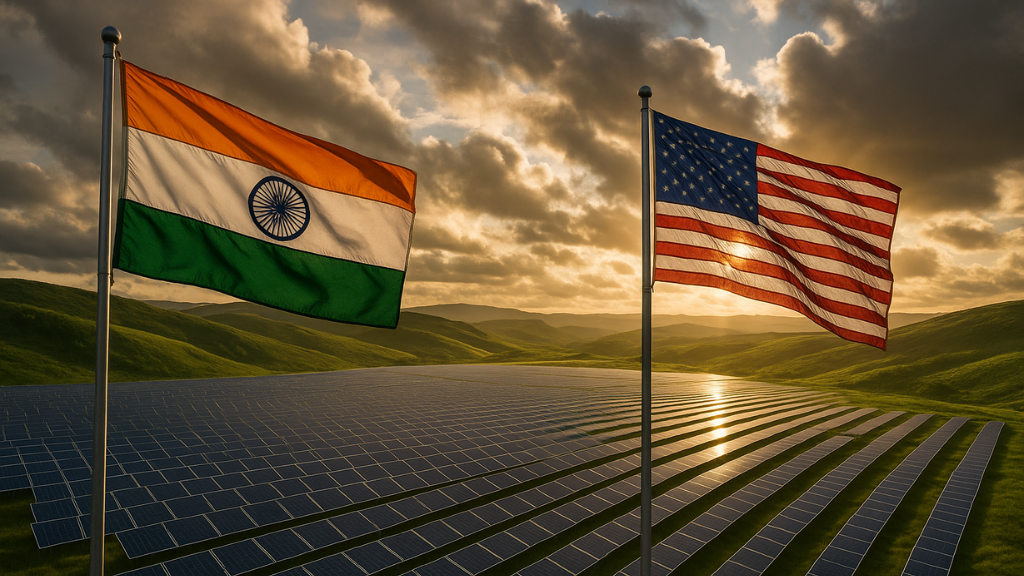The global solar industry is witnessing a shift. At the heart of this shift lies India’s rise as America’s solar manufacturing partner of choice.
Just three years ago, India’s solar module exports to the world totaled $85 million. Today, that figure has grown to billions, signaling a fundamental shift in the global solar ecosystem. Indian manufacturers have emerged as the reliable, quality-driven partners the world has been looking for.
The Numbers That Changed Everything
The numbers tell a clear story of market dominance. According to a report by the Institute for Energy Economics and Financial Analysis (IEEFA) and JMK Research, India’s solar module exports hit $2 billion in fiscal 2024 which is a massive jump from previous years. What’s more important is how the United States has become India’s main customer, taking 97% of India’s solar exports in fiscal 2023 and 99% in fiscal 2024.
This goes beyond just numbers, it’s about trust. When American solar companies put almost all their Indian solar purchases in one market, it shows they believe in the quality and reliability of Indian manufacturing. The data shows that India has taken over the India-to-America solar trade.
India also surpassed South Korea last year to become the fifth-largest solar exporter to the United States. This puts Indian manufacturers among the top suppliers to the world’s second-largest solar market, showing how quickly the industry has grown and focused on strategy.
Convergence of Market Forces
Several connected factors have created the right conditions for India’s solar export boom, each one strengthening the others to build momentum that keeps growing.
Supply Chain Diversification Imperative
The “China Plus One” strategy has become a must-have. Companies around the world are working to diversify their supply chains and reduce their dependence on single-source manufacturing. India has become the best alternative, offering manufacturing capability, competitive costs, and political stability that few other countries can provide.
This diversification is about managing risk and creating strong, sustainable supply chains that can handle global disruptions while keeping quality high and costs reasonable. Indian manufacturers have positioned themselves perfectly to meet this demand.
Domestic Market Dynamics Creating Export Opportunities
India’s own policy changes have actually helped boost exports. The delayed implementation of the Approved List of Models and Manufacturers (ALMM) in April 2024 temporarily reduced domestic demand for solar modules. Instead of seeing this as a problem, Indian manufacturers shifted their focus to international markets, especially the United States.
Evolving Trade Landscape
The end of certain Free Trade Agreements and ongoing antidumping and countervailing duty investigations have changed the competitive landscape. With these changes, India could potentially replace Southeast Asian countries as the leading solar exporting region to the United States. This shift represents a chance for Indian manufacturers to build long-term partnerships with American stakeholders.
Strategic Benefits: A Partnership That Works
The surge in Indian solar exports to America benefits both markets in ways that go far beyond trade numbers.
For Indian manufacturers, working in the demanding US market drives improvement and growth. As Vibhuti Garg, Director – South Asia at IEEFA and contributing author of the key report, explains: “Focusing on the US market can benefit the Indian PV manufacturing ecosystem. The exposure to the US market will enable Indian PV manufacturers to attain economies of scale, ultimately enhancing their product quality and competitiveness.”
This touches on a basic principle of manufacturing excellence: demanding customers drive innovation and quality improvements that benefit everyone. American buyers, known for their strict standards and quality requirements, push Indian manufacturers to continuously improve their processes, products, and capabilities.
GREW Solar: Leading India’s Manufacturing Excellence
Within this broader story of Indian solar success, GREW Solar shows how Indian manufacturers are not just participating in the American market but leading it through innovation, quality, and strategic vision.
GREW Solar’s approach to the American market reflects the broader Indian strategy of delivering superior quality products that meet the high standards of US buyers while maintaining the cost competitiveness that makes solar energy accessible and economical. With manufacturing facilities strategically located across 350+ acres in Rajasthan, Madhya Pradesh, and Jammu & Kashmir, GREW Solar has built the scale and capability needed to serve large American projects while maintaining the flexibility to meet diverse customer requirements.
The UFLPA-compliant supply chain addresses one of the most critical concerns for American buyers i.e. transparency and ethical sourcing. In a market increasingly focused on supply chain integrity, GREW Solar’s commitment to responsible manufacturing practices provides American customers with the confidence they need to specify its products for their projects.
The Road Ahead
The transformation of India from a small player to a major force in the American solar market represents the emergence of a sustainable, long-term partnership that benefits both nations’ clean energy goals.
For India, success in the American market proves the country’s manufacturing capabilities and opens doors to other international opportunities. The experience gained from serving the world’s most sophisticated solar market will improve Indian manufacturers’ capabilities and competitiveness globally.
For America, Indian manufacturers provide a crucial element in building a resilient clean energy supply chain. As the United States works toward its ambitious clean energy targets, having reliable, high-quality suppliers outside of traditional manufacturing centers becomes not just helpful but essential.
The relationship also creates opportunities for technology transfer, joint innovation, and collaborative development of next-generation solar technologies. As both countries invest heavily in renewable energy research and development, the commercial relationships being built today could evolve into strategic partnerships that advance the entire global solar industry.


